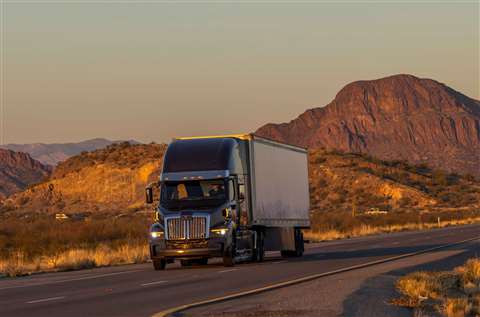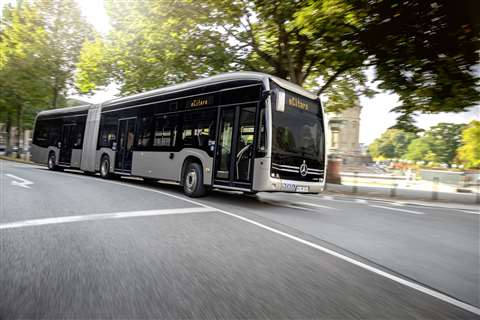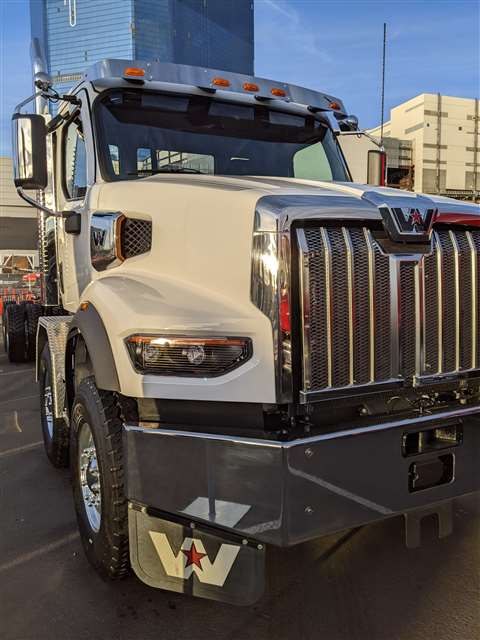When it comes to U.S. transport, don’t count diesel out just yet
23 August 2022
Research shows diesel’s days on U.S. roadways aren’t quite as numbered as some suggest
 Just as commercial trucks dominate U.S. roadways, diesel dominates U.S. trucking, according to a Diesel Technology Forum analysis. (Photo: Western Star 57X / Western Star)
Just as commercial trucks dominate U.S. roadways, diesel dominates U.S. trucking, according to a Diesel Technology Forum analysis. (Photo: Western Star 57X / Western Star)
When Samuel Clemens (otherwise known as Mark Twain) was told of reports of his death, he was famously quoted as saying: “The reports of my death are greatly exaggerated.” While a bit of a misquote, the point was clear: there was still plenty of life in the aging humorist just yet.
You could argue the same applies to the diesel engine and diesel fuel amidst predictions of their pending demise. Though the end of days may be inevitable as alternative technologies emerge, reports of their imminent decline in the face of new power sources seems an exaggeration, at least if recent research is any indication.
For nearly a decade, the Diesel Technology Forum has examined vehicle use statistics published by automotive information specialist S&P Global Mobility from State Departments of Motor Vehicle data in order to monitor trends in power system technology used in the transportation industry.
“We analyze it and try and understand what… generations of diesel technology are on the road operating today, how has that changed and, some years, we’ve asked questions about ‘what does that mean for society in terms of emissions and other benefits, fuel savings for the customer, etc.’” explained Allen Schaeffer, executive director, Diesel Technology Forum.
The analysis provides “a chance to really understand what’s happening on the ground right now with diesel in these sectors,” he added, which include commercial trucking, transit buses and school buses.
Where diesel dominates
It’s not surprising that the largest of the three sectors studied is commercial trucking. According to industry estimates, there are as many as 15.5 million commercial trucks operating in the U.S., including 2 million tractor-trailer units, compared to around half a million school buses and roughly 100,000 transit buses.
And just as trucks dominate U.S. roadways, diesel dominates U.S. trucking. “There’s certainly a lot of discussion about new fuels and technologies that are emerging and lots of coverage of that in the media and other places,” Schaeffer acknowledged. “But you know, when the rubber meets the road, [it’s] the numbers that matter.
“Diesel power is about 76% – more than three-quarters – of all of the commercial vehicles Class 3 through 8 nationwide. That statistic hasn’t changed since the last time we looked at this data in 2020,” he pointed out. “If we’re talking about the largest trucks, the Class 8 tractor-trailer types, in that case, 97% of those are powered by diesel. So, it’s a much larger and more significant percent of the population that’s driven by diesel today.”
What has changed is the number of trucks operating with current emissions technology, as new trucks are cycled into fleets and older models are cycled out.
“Back when we started this [in 2016], only about 30% of the trucks on the road at that time were 2011 and later model year. By last year, the end of 2021, that 30% had turned into 53%,” said Schaeffer. “So, it’s a pretty steady progression.”
This is an important milestone given 2011 marked a major shift in emissions technology to near-zero NOx emissions, Schaeffer noted, adding, “more than half of every truck out there on the road going past you today is the newest generation of diesels that are super clean.”
Buses start to see a shift
The two bus sectors studied show a decidedly different trend, though the changes aren’t yet as dramatic as one might expect.
 Diesel fell nearly 5% in transit buses from the previous year as more electric and natural gas buses were put into service. (Photo: Daimler Buses)
Diesel fell nearly 5% in transit buses from the previous year as more electric and natural gas buses were put into service. (Photo: Daimler Buses)
For example, according to the Forum’s analysis, 79% of transit buses in operation are diesel powered, compared to 84% the previous year. “We saw a loss of about 4% or 5% in the number of transit buses that were powered by diesel. And that’s, I think, no surprise,” said Schaeffer. “There have been a number of both natural gas as well as electric transit buses put into service in the previous year. Natural gas makes up about 10% of the transit bus market, electric is about 6% and other technologies… make up the remainder.”
The school bus sector saw a similar decline but from a higher level, falling to 91% diesel compared to 95% the last time the statistics were studied. Schaeffer attributes the decline to an aggressive push by manufacturers to advance electric school bus fleets, as well as government funding and incentives to invest in zero-emissions vehicles.
“In future years, I would expect [this share] to diminish even further given the Biden administration’s significant investment in electric school buses to encourage a transition there,” said Schaeffer.
Will regulations force trucking’s hand?
The government seems determined to give commercial trucks a push toward alternative power, as well, but in this case through regulation.
The Clean Trucks Plan announced by the Environmental Protection Agency (EPA) last August portended a series of rulemakings targeted at reducing NOx pollutants in heavy trucks, starting with model year 2027. The regulations, scheduled to be introduced this December, “will include an update of current greenhouse gas (GHG) standards to capture market shifts to zero-emission technologies in certain segments of the heavy-duty vehicle sector.”
 The government seems determined to give commercial trucks a push toward alternative power through more stringent regulations. (Photo: Chad Elmore)
The government seems determined to give commercial trucks a push toward alternative power through more stringent regulations. (Photo: Chad Elmore)
Yet, while the objective appears to be to move commercial trucking away from diesel, Schaeffer is skeptical of its short-term impact. “We’ll wait sort of to see what those rules look like and what they require in terms of further reductions in emissions or gains in efficiency from these vehicles. But I think, by and large, the expectation is that diesel is going to continue to dominate most of these sectors for some time to come,” he stated. “And that ‘time to come’ is probably measured in a decade or decades, particularly in the case of the Class 8 vehicles.”
Whereas he anticipates some diesels will be replaced in other vehicles where new technologies and fuels are heavily incentivized, the extreme dominance of diesel in the Class 8 space will “take a tremendous amount of time, funding and other motivations” to encourage that shift to a point where it makes sense, said Schaeffer. Questions related to both costs and infrastructure must be answered.
“We don’t have adequate charging infrastructure for heavy-duty electric vehicles along our nation’s interstates and freight grounds. We don’t have it today, and what’s the reasonable expectation for that to come along? Is it next year? Is it five years, 10 years?” Schaeffer asks. “I think these things are likely to take a lot longer than we might anticipate at this point.”
As such, he perceives any time frames being targeted for a meaningful transition away from diesel, particularly in the largest trucks, as “more aspirational… as opposed to concrete sorts of milestones.”
A faster path to lower emissions
A much quicker path to lower GHG in commercial trucking lies not in new technologies, said Schaeffer, but in those that already exist.
“We have [some very interesting research] that shows quite clearly that, particularly in the next decade (2022 to 2032), the fastest way to get more GHG reduction and clean air benefits through lower NOx and PM is not through electrification, but rather through accelerating the turnover of the oldest trucks to the new advanced generation of diesel,” he said. “If those vehicles are then all using renewable biodiesel fuels, the GHG benefits are three times greater than we’d likely see from electrification, and they are attainable with only 25% of the cost investment.”
The challenge, he said, is the mindset that electrification is the fastest way, best or only way to reduce GHG emissions in the commercial truck sector. As a result, a change in fuels tends to be overshadowed.
“We haven’t changed diesel fuel really since 2006, when you get right down to it. But if we start using some of these advanced renewable biodiesel fuels, there is a tremendous benefit available in carbon reduction – 50% to 90% carbon reduction – over diesel,” Schaeffer emphasized. “And that can happen overnight, without any changes in infrastructure or vehicles.
“As we step back and think about why we’re talking about all these new fuels and technologies, it’s really to help address the global climate challenge. There are many ways to reduce carbon emissions,” he said. “And the use of advanced diesel technology and these low carbon renewable fuels are really one of those that deserve more consideration.”
STAY CONNECTED




Receive the information you need when you need it through our world-leading magazines, newsletters and daily briefings.
POWER SOURCING GUIDE
The trusted reference and buyer’s guide for 83 years
The original “desktop search engine,” guiding nearly 10,000 users in more than 90 countries it is the primary reference for specifications and details on all the components that go into engine systems.
Visit Now
CONNECT WITH THE TEAM










